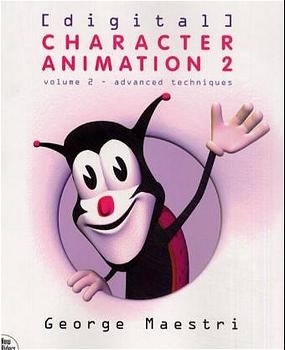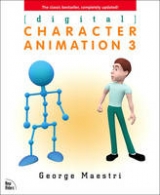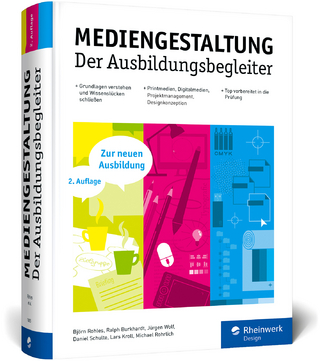
Digital Character Animation 2, Volume II
New Riders Publishing (Verlag)
978-0-7357-0044-4 (ISBN)
- Titel erscheint in neuer Auflage
- Artikel merken
As soon as George Maestri's classic (digital) Character Animation was released, people began asking when he was going to do on edition for trully high-end users with the most advanced skill sets. Here it is; George writes directly to CG professionals, with more non-software-specific approaches to character animation.
Growing up in Arizona, George Maestri was well renowned as the kid who could always draw a really cool Camaro. He got his first taste of computers before high school when he taught himself to program computer games on his Dad's mainframe. He landed his first programming job at age 16, writing code for the Altair 8800. He earned a degree in computer science and Silicon Valley quickly seduced him, where he worked as an engineer on early Unix-based graphics systems in the '80s. After a few years, he noticed that the people who created art on computers had a lot more fun than the engineers who made the machines. This sparked an early midlife crisis and George embarked on a career change. George enrolled in the animation program at DeAnza College in Cupertino, California, and was soon making his own student films. There he met Joe Murray, who had just pitched an animated series idea to Nickelodeon. Joe hired George to help with development of Rocko's Modern Life. Soon after that, George found himself working day and night on the pilot as an animator and assistant producer. Miraculously, the show was picked up, and George moved to Los Angeles in 1993, where he worked on Rocko's Modern Life as a writer for the entire run of the show, earning a Cable Ace nomination in the process. During his time at Nickelodeon, George taught himself 3D animation. His interest in this subject soon landed him a monthly column covering 3D animation for DV magazine. George has continued working as a freelance journalist, writing articles on animation production for magazines such as Computer Graphics World, Animation Magazine, Film & Video, and Digital Magic. In 1995, George found himself at Film Roman as a writer and creator, developing new concepts for animated series. Several of his projects were picked up for development by major networks. George also got his first taste of 3D animation production, animating a 3D Felix for the CBS Series The Twisted Tales of Felix the Cat. George worked as a freelance animation director until he was hired as the original animation producer on South Park in 1997. In this capacity, George ramped up production and hired the original staff of artists, animators, and technical directors. He also used his computer background to develop the techniques and technology for animating cut-out characters using Alias. After South Park, George went back to freelancing and found himself on the road. He taught animation at NanYang Polytechnic in Singapore and then flew to Paris to direct a live-action/3D pilot at Medialab for Film Roman. George then became an animation consultant at Curious Pictures in New York, where he helped set up the production of A Little Curious, the first TV series animated in Maya. During this time, George was creating and pitching his own projects. He sold two properties into development: The Experts (co-developed with Jerry Beck) to Warner Bros., and The Forgotten Ones to Disney/ABC. George wrote and directed both pilots. In 1999, The Experts was renamed Karen & Kirby and George's characters became part of the Kids WB family. George set up the production and directed all 13 of the three-minute episodes, which aired during The Big Cartoonie Show. George, along with Jerry Beck, also acted as story editor. One of these episodes, "When Animals Go Berserk," was shown to wide acclaim at a number of festivals, including the LA Animation Celebration and Siggraph 2000. George is the author of Digital Character Animation 2, Volume I: Essential Techniques (New Riders, 1999). He is also the editor of the New Riders digital series.
(NOTE: Each chapter concludes with a Conclusion.)
Introduction.
1. Real World Production.
Getting Started in Filmmaking. Making a Film. Distribution.
2. Story.
Characters and Story. Story Through Action. Visuals Come First. Developing a Story. Developing a Script. Visualizing Your Story. Finalizing Your Story.
3. Rigging Characters.
Sliders. Automation. Wiring Things Together. Skeletal Setups. Facial Rigging Replacement Animation. Skinning.
4. Animation Tips & Tricks.
Making Characters Think. Dialogue. Facial Animation. Animating the Body. Takes and Double Takes. Animating Laughter. Multiple Characters. Environment.
5. Human Motion.
Using Reference. Balance and Weight. Character Mass. How the Body Moves. Animating Locomotion. Dealing with External Forces. Animating Rhythm and Dance. Martial Arts.
6. Acting.
Acting Versus Animating. Acting and Story. Know Your Tools. Know Your Audience. Know Your Characters. Acting Technique. Acting and the Body. Other Techniques.
7. Animal Motion.
Four-Legged Mammals. Other Four-Legged Gaits. Reptiles. Snakes. Dinosaurs. Insects and Spiders.
8. Anthropomorphic Animation.
How Real Can You Go? Creating Your Character. Modeling Your Character. Animating Objects.
9. Games.
Producing Games. Platforms. Game Design. Creating Characters for Games. Animating for Games. Cycles. Moving Characters. Flowcharting.
Index.
| Erscheint lt. Verlag | 21.8.2001 |
|---|---|
| Sprache | englisch |
| Maße | 205 x 255 mm |
| Gewicht | 577 g |
| Themenwelt | Mathematik / Informatik ► Informatik ► Grafik / Design |
| ISBN-10 | 0-7357-0044-3 / 0735700443 |
| ISBN-13 | 978-0-7357-0044-4 / 9780735700444 |
| Zustand | Neuware |
| Haben Sie eine Frage zum Produkt? |
aus dem Bereich



